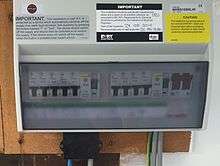National Inspection Council for Electrical Installation Contracting
 RCD circuit breaker, with NICEIC logo on the BS 7671 Requirements for Electrical Installations | |
| Abbreviation | NICEIC |
|---|---|
| Formation | 1956 |
| Legal status | Voluntary body |
| Purpose | Electrical installation training regulatory organisation |
| Headquarters | Warwick House, Houghton Hall Park |
| Location | |
Region served | UK |
Membership | Electricians |
Chief Executive Officer | Emma Clancy |
Parent organization | Certsure |
| Website | http://www.niceic.com |
| Relevant topics on |
| Electrical installations |
|---|
| Wiring practice by region or country |
| Regulation of electrical installations |
| Cabling and accessories |
| Switching and protection devices |
The National Inspection Council for Electrical Installation Contracting (NICEIC) is one of several organisations which regulates the training and work of electrical enterprises in the UK. The NICEIC is one of several providers given Government approval to offer Competent Person Schemes to oversee electrical work within the electrical industry.
Certsure LLP (which is owned by Electrical Safety First, a registered charity, and the Electrical Contractors’ Association (ECA), the electrotechnical industry trade body) trades under the certification brands NICEIC and ELECSA.
History
From 1923, an earlier organisation, the National Register of Electrical Installation Contractors, kept a register of approved electricians. It was incorporated on 10 August 1956, and since 1 October 2005, it has been registered as The Electrical Safety Council.
Regulation
Electrical contractors register with the organisation to become approved contractors, meeting the NICEIC's specification of training. If work undertaken by the approved contractor is not up-to-standard, the NICEIC will correct it if necessary. Work is checked by 54 local Area Engineers. Many local authorities only give work to NICEIC-approved electricians.
Most electrical items in domestic wiring are controlled from the consumer unit with its residual-current device (RCD), which since 2001 has to be installed. Homes are wired in a ring circuit.
To be an approved contractor, the electrician must:
- Ensure work is carried out to the current edition of BS 7671; the IET Wiring Regulations
- Ensure certification is issued on completion of installation work, as directed by BS 7671
- Have up-to-date copies of BS 7671
- Have competence with test instruments as outlined by Part 6 ("Inspection and Testing") of BS 7671; the IET Wiring Regulations
- Have public liability insurance of at least £2m.
See also
- British Approvals Service for Cables
- Electrical wiring in the United Kingdom
- Gas Safe Register and its predecessorCouncil for Registered Gas Installers (CORGI)
- Electrical Contractors' Association
- SELECT (Electrical Contractors' Association of Scotland)
- Electrical Safety First, an education charity formed in 2005 formed from the NICEIC